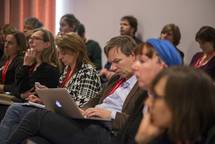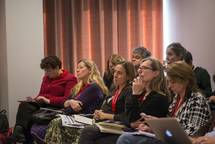New skills and professionalization for the Digital Arena
Scholars, students, experts from museums, libraries and national archives joined the CreativeCH team at the DISH 2013 conference in Rotterdam to explore which competencies are a must in the curriculum of practitioners wishing to create innovative heritage products, to discuss how to improve the training background of heritage professionals in order to allow them to keep up-to-date with new, constantly changing technologies.
Franco Niccolucci welcomed the audience by introducing himself and briefly explaining the reasons behind the absence of two of the workshop’s guest speakers.
He then proceeded to present the CreativeCH project and outlined the four local showcases, a central part of the project. To illustrate the activities of the Tuscan showcase, a short video-clip of the experience in Maremma was aired, with frequent explanations on the techniques used to communicate Etruscan heritage to tourists visiting southern Tuscany during the summer months.
The theme of part of this showcase in fact was the re-enactment of the commercial routes employed by the Etruscans to bring goods and wares from the coastal areas to the inland settlements.
The objects were printed using an inexpensive 3D scanner and printer, used both for educational and for conservation purposes. The replicas are useful, as they allow visitors to touch and get a feel of the objects, without actually handling the precious and fragile original. However, this technique is not cost-effective when larger artefacts, for example amphorae, are chosen for reproduction. In the latter case, a more traditional solution was found, that is the items were made by specialized artisans.
These re-enactments and the experimental archaeology activities alone were not sufficient to guarantee long-term sustainability, so a series of applications, available for free from the iTunes Store, were developed to replicate the itineraries around the archaeological sites of Rusellae and Vetulonia.
These are just a few apps in the Tourbook series, which will be enriched in future with new destinations and routes.
Next, Paula Simões, a researcher from the University of Coimbra in Portugal, discussed the experiences deriving from the development of the EuroMACHS Master Programme.
Heritage professionals are placed in a new context, where the role of heritage in innovation, economic and social development is greater than ever before. There are many opportunities linked to Cultural and Creative Industries, as heritage-based digital media products become commonplace.
The new professional, therefore needs to be competent not only in his/her particular area of Cultural Heritage, but must also have an understanding of a series of interdisciplinary skills, ranging from digital technologies, creativity, business management, digital rights, and so on. Education programs are still lacking in this respect, they do not prepare students for an interdisciplinary creative approach to communicating heritage.
In this scenario, the University of Coimbra developed a programme in Heritage and Digital Media, targeting first cycle graduates in Humanities, who wish to develop a flexible combination of knowledge, skills and competences.
Students were given the possibility of “going out” through internships and learned how to deal with external customers. An important lessons were learned from this experience: first and foremost is content; a collective learning environment ensures the success of the educational project; students focussed on the user’s experience; a controlled simulation of real product development was also instrumental in the implementation of the project.
Franco Niccolucci took the stand once again in lieu of one of the absent speakers and invited the workshop participants to openly discuss their view on the topic. The three questions, which were the foundation on which the present debate rested on, were posed. Older, traditional manual skills should not be completely abandoned for the latest digital technologies, as often they are not only more appreciated by the end-user, but also because they provide a better perspective of heritage.
So today’s heritage professional must be well-versed in the latest technological advancements, in order communicate heritage effectively to a digitally literate public. At the same time they must possess a solid background in historical facts.
The presentations and subsequent discussion underlined that education institutions need to address the challenges posed by an interdisciplinary approach more effectively.
The business side of project development is one major aspect, which should be taken into greater consideration: knowing how to manage the funds received to successfully complete a project is of great importance.
Workshop Video recap
Workshop Fotos
Download Videos and Presentations of the Workshop
Videoclip of Notti dell'Archeologia [English subtitles]
Le notti dell'archeologia [PDF IT]
Paula Simoes - Educational Challenges of the New Heritage [PDF EN]
Meet the Speakers
The next workshop will host as speakers Reimer Knoop and Massimo Negri.
Contact us
For more information, registrations and details,
please ask your contact person Stephanie Williams






